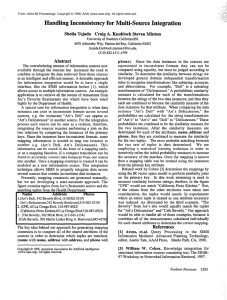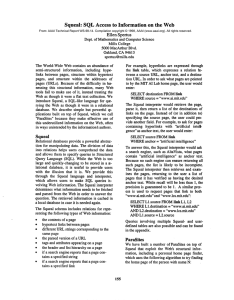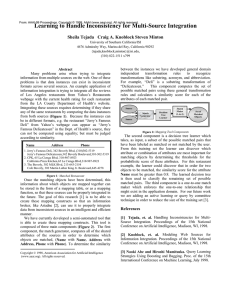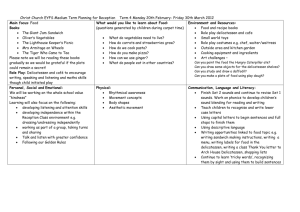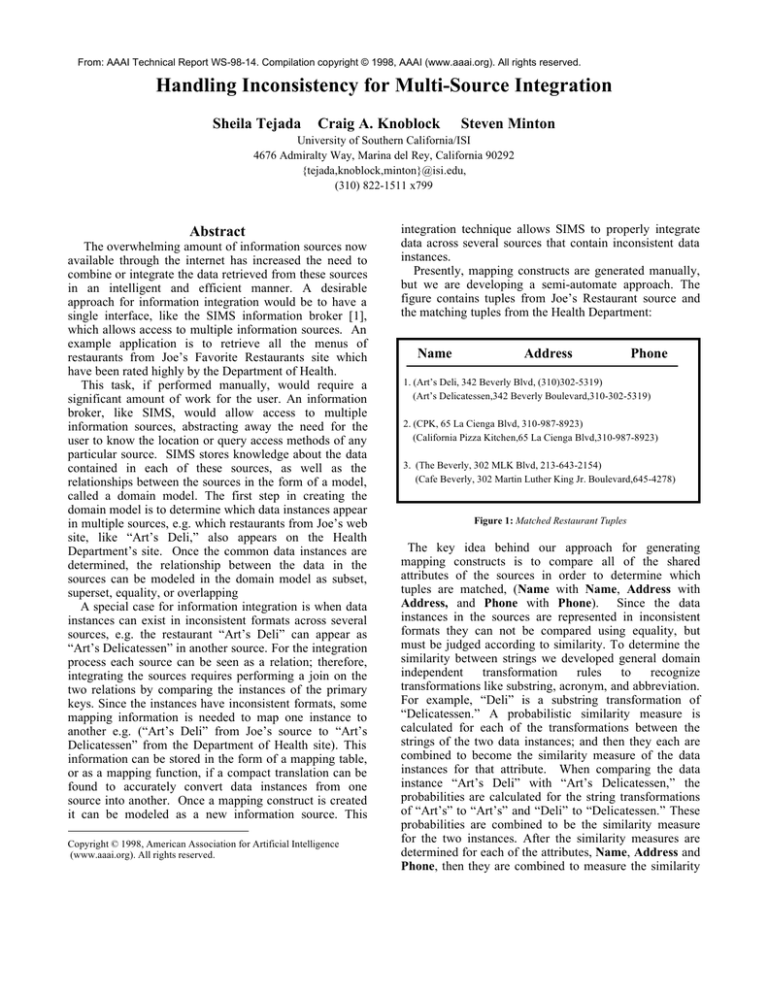
From: AAAI Technical Report WS-98-14. Compilation copyright © 1998, AAAI (www.aaai.org). All rights reserved.
Handling Inconsistency for Multi-Source Integration
Sheila Tejada
Craig A. Knoblock
Steven Minton
University of Southern California/ISI
4676 Admiralty Way, Marina del Rey, California 90292
{tejada,knoblock,minton}@isi.edu,
(310) 822-1511 x799
Abstract
The overwhelming amount of information sources now
available through the internet has increased the need to
combine or integrate the data retrieved from these sources
in an intelligent and efficient manner. A desirable
approach for information integration would be to have a
single interface, like the SIMS information broker [1],
which allows access to multiple information sources. An
example application is to retrieve all the menus of
restaurants from Joe’s Favorite Restaurants site which
have been rated highly by the Department of Health.
This task, if performed manually, would require a
significant amount of work for the user. An information
broker, like SIMS, would allow access to multiple
information sources, abstracting away the need for the
user to know the location or query access methods of any
particular source. SIMS stores knowledge about the data
contained in each of these sources, as well as the
relationships between the sources in the form of a model,
called a domain model. The first step in creating the
domain model is to determine which data instances appear
in multiple sources, e.g. which restaurants from Joe’s web
site, like “Art’s Deli,” also appears on the Health
Department’s site. Once the common data instances are
determined, the relationship between the data in the
sources can be modeled in the domain model as subset,
superset, equality, or overlapping
A special case for information integration is when data
instances can exist in inconsistent formats across several
sources, e.g. the restaurant “Art’s Deli” can appear as
“Art’s Delicatessen” in another source. For the integration
process each source can be seen as a relation; therefore,
integrating the sources requires performing a join on the
two relations by comparing the instances of the primary
keys. Since the instances have inconsistent formats, some
mapping information is needed to map one instance to
another e.g. (“Art’s Deli” from Joe’s source to “Art’s
Delicatessen” from the Department of Health site). This
information can be stored in the form of a mapping table,
or as a mapping function, if a compact translation can be
found to accurately convert data instances from one
source into another. Once a mapping construct is created
it can be modeled as a new information source. This
Copyright © 1998, American Association for Artificial Intelligence
(www.aaai.org). All rights reserved.
integration technique allows SIMS to properly integrate
data across several sources that contain inconsistent data
instances.
Presently, mapping constructs are generated manually,
but we are developing a semi-automate approach. The
figure contains tuples from Joe’s Restaurant source and
the matching tuples from the Health Department:
Name
Address
Phone
1. (Art’s Deli, 342 Beverly Blvd, (310)302-5319)
(Art’s Delicatessen,342 Beverly Boulevard,310-302-5319)
2. (CPK, 65 La Cienga Blvd, 310-987-8923)
(California Pizza Kitchen,65 La Cienga Blvd,310-987-8923)
3. (The Beverly, 302 MLK Blvd, 213-643-2154)
(Cafe Beverly, 302 Martin Luther King Jr. Boulevard,645-4278)
Figure 1: Matched Restaurant Tuples
The key idea behind our approach for generating
mapping constructs is to compare all of the shared
attributes of the sources in order to determine which
tuples are matched, (Name with Name, Address with
Address, and Phone with Phone). Since the data
instances in the sources are represented in inconsistent
formats they can not be compared using equality, but
must be judged according to similarity. To determine the
similarity between strings we developed general domain
independent
transformation
rules
to
recognize
transformations like substring, acronym, and abbreviation.
For example, “Deli” is a substring transformation of
“Delicatessen.” A probabilistic similarity measure is
calculated for each of the transformations between the
strings of the two data instances; and then they each are
combined to become the similarity measure of the data
instances for that attribute. When comparing the data
instance “Art’s Deli” with “Art’s Delicatessen,” the
probabilities are calculated for the string transformations
of “Art’s” to “Art’s” and “Deli” to “Delicatessen.” These
probabilities are combined to be the similarity measure
for the two instances. After the similarity measures are
determined for each of the attributes, Name, Address and
Phone, then they are combined to measure the similarity
for the two tuples. The most probable matching between
the two sets of tuples is then determined. We are
employing a statistical learning technique in order to
iteratively refine the initial probability measures to
increase the accuracy of the matches. Once the mapping
is known then a mapping table or function can be created
using the instances from the primary key attribute.
Some related work has conducted by Huang & Russell
[2] on matching tuples across relations using a
probabilistic appearance model. Their approach also
incorporates the idea of comparing the tuples based on of
all of the shared attributes.
To determine similarity
between two instances, they calculate the probability that
given one instance it will appear like the second instance
in the other relation.
Calculating these probabilities
requires a training set of correctly paired tuples (like the
tuples in the figure).
Unfortunately, appearance
probabilities will not be helpful for an attribute with a
unique set of instances, like Restaurant Name. Since
“Art’s Deli” only occurs once in the set of instances,
knowing that it appears like “Art’s Delicatessen” does not
help in matching any other instances. In our approach
the initial probability measures are calculated for the
strings of instances that match using a specific
transformation rule; therefore, having matched “Art’s
Deli” with “Art’s Delicatessen” will increase the
probability of “Deli” as a substring of “Delicatessen.”
This will increase the probability for other instances
which use that specific transformation.
Other related work by Cohen [3] determines the
mappings by using the IR vector space model to perform
similarity joins on the primary key. In this work
stemming is used to measure similarity between strings;
therefore, in the figure “CPK” would not match
“California Pizza Kitchen.” But, if the values from the
other attributes were taken into consideration, the tuples
would match. In experiments where an entire tuple is
treated as one attribute accruracy was reduced. As
illustrated by the third example, “The Beverly” from Joe’s
site would equally match the tuples for “Art’s
Delicatessen” and “Cafe Beverly.” Our approach would
be able to handle all of these examples, because it
combines all of the measurements calculated individually
for each shared attributes to determine the correct
mapping.
References
[1] Arens, et.al. Query Processing in the SIMS
Information Mediator. Advanced Planning Technology,
editor, Austin Tate, AAAI Press, Menlo Park, CA, 1996.
[2] Timothy Huang and Stuart Russell. Object
Identification in Bayesian Context. Proceedings of
IJCAI-97. Nagoya, Japan 1997.
[3] William W. Cohen. Knowledge integration for
structured information sources containing text. The
SIGIR-97 Workshop on Networked Information Retrieval,
1997.

